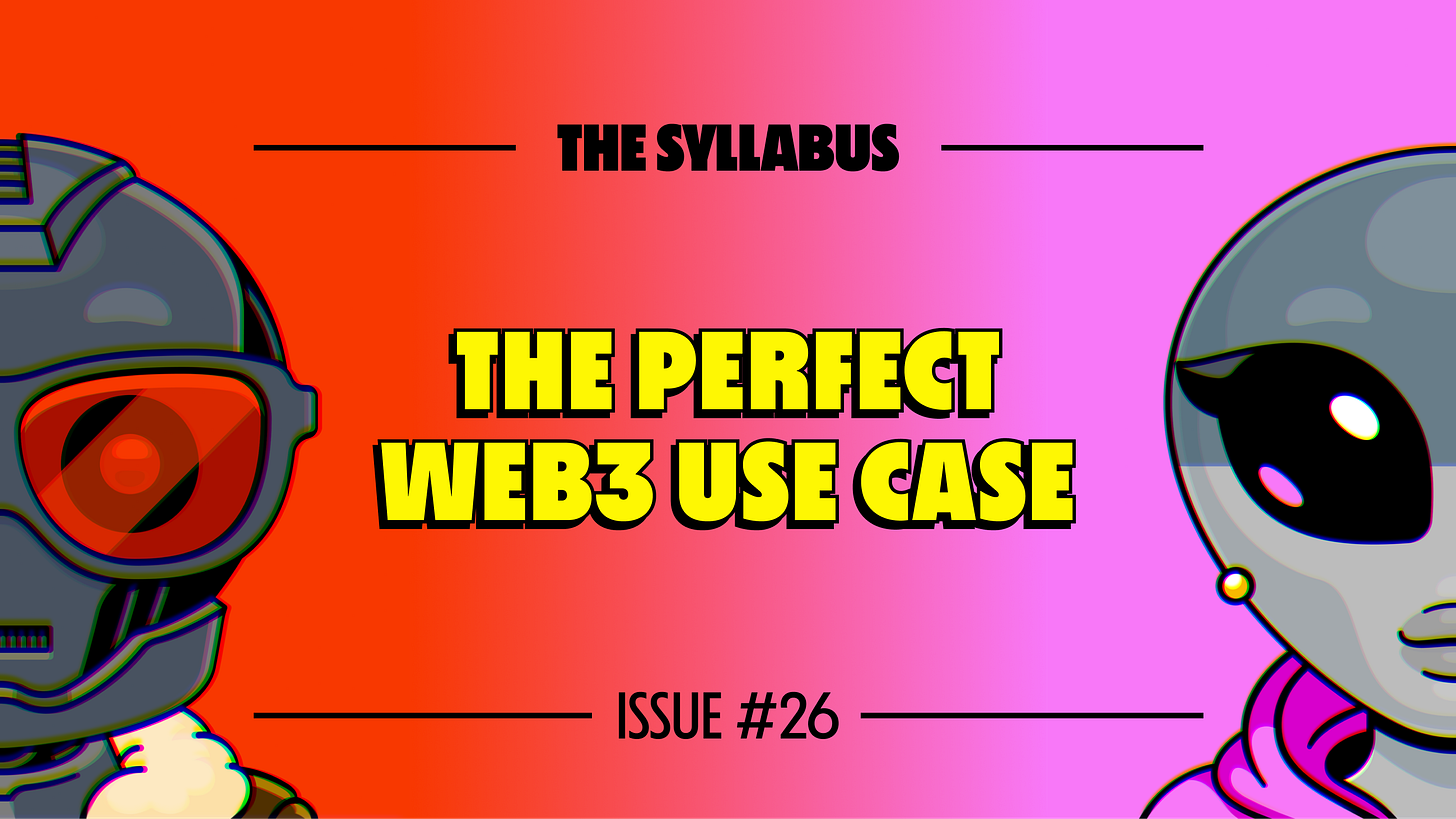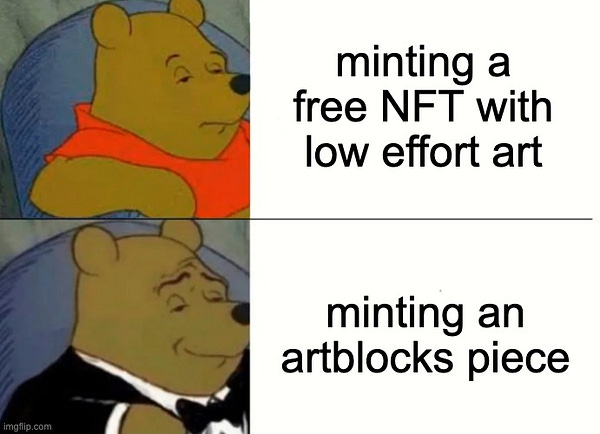👋 Welcome to the 26th issue of The Syllabus from Invisible College — a weekly newsletter that helps you navigate the fast-moving world of web3. To get this newsletter delivered to your inbox, subscribe here:
Before we begin, a disclaimer — nothing in this piece should be construed as financial advice. With that, let’s dive in.
Upcoming Events
We’ve got a packed event calendar over the next two weeks. Here’s what’s coming up:
NFTuesday (Tues. 7/19 @ 3 pm PT)*
Creating On-Chain Communities (Wed. 7/20 @ 9 am PT)*
Investing in the Metaverse (Thurs. 7/21 @ 3 pm PT)*
Town Hall (Fri. 7/22 @ 9 am PT)*
Office Hours w/ Rockwell Shah (Mon. 7/25 @ 1 pm PT)*
*To access these events, you’ll need to hold at least one Decentralien NFT.
Now onto this week’s post…
In the past year, profile pic (PFP) NFTs have taken the crypto world by storm. They’ve mostly overshadowed more traditional-looking art. But generative art NFTs have been experiencing a resurgence of late.
Generative art NFTs aren’t new. Some of them date back to the earliest NFTs ever created. And despite the bear market, there have been some eye-popping sales:
What is generative art, why are NFTs the ideal use case for it, why are some generative art NFTs so valuable, and why are they suddenly rising in popularity again?
Let’s dig in.
A very brief history
Generative art emerged from previous movements such as Cubism, Dadaism, and Surrealism. Instead of grabbing a pen or a brush, modern generative artists use code to create their work with little, if any, input from themselves going into the final product.
The generative art movement predates computers, but it really began to take off in the late 20th century as personal computers became more affordable and ubiquitous. It was derided at first, with generative artists being written off as not “real” artists because they relinquish control of the final output of their work to a machine.
Many of these artists plugged away for decades, producing work for small audiences, mostly because they loved it, not because they were making a living.
NFTs unlocked a way to reach a new digital-native audience who were hungry to collect and speculate with their recent crypto gains—a true product-market-fit use case.
The perfect use case
Some people may argue that PFP NFTs are generative art. After all, they’re typically a collection of images with different traits and an algorithm assembles those traits to determine their rarity. But in that case, the artist knows what all the traits look like beforehand, they just don’t know exactly how they will be assembled.
Generative art is different. When a user mints a generative art NFT, both the user and the artist don’t know what it will look like. Minting triggers the code the artist wrote, which then works its magic to produce a piece. Of course, the artist will have an idea of what it’ll look like, but ultimately the algorithm they write will produce the final product.
Sometimes the results will be stunning and sometimes they won’t. But, as they say, beauty is in the eye of the beholder. As a user, it feels a bit like rolling the dice. But that’s also part of the fun of minting NFTs.
And just like any other NFT, once a generative art NFT is minted, it becomes an asset that can easily be traded on marketplaces such as OpenSea, LooksRare, and others. This instantly creates a more liquid market, thus potentially driving values up more quickly than the traditional art market.
Top collections
Here are a few of the collections that go for some of the highest prices in the entire NFT space:
Autoglyph
These were the first on-chain generative art NFTs, which gives them historical value. They were created by Larva Labs, the same developers who created the Cryptopunks collection.
The current floor price, as of this writing, is a whopping 299.95 ETH. Here’s a recent one that sold for $310,807.04:
Fidenza
This collection was created by Tyler Hobbs, a generative artist who has been producing art well before NFTs existed. He had been playing with and refining the algorithmic technique used in the Fidenza collection since 2016, well before launching the collection of 999 NFTs in June 2021.
The current floor price is 105 ETH. This was a recent sale for $157,257.50:
Ringers
Artist Dmitri Cherniak has been in the crypto space since 2014. He was one of the first developers to implement Coinbase’s tipping widget, enabling crowdfunding for Bitcoin journalism. Shortly afterward, he also started accepting Bitcoin payments for his artwork. He went on to explore generative art using algorithms and developed Ringers, a collection of 1,000 NFTs with a combination of peg and string layouts created without any human interaction.
The current floor price is 58.69 ETH. This one sold for $81,407.95 recently:
Recent resurgence
The NFT market has been overrun with PFP projects. For every Moonbirds-type project, there are a bunch of derivatives like AI Nightbirds, 3DBirds, Moonrunners, Moonbats, and a bunch more.
The replies to this tweet are filled with NFT projects for just about every imaginable animal you can think of:
There are simply too many PFP projects to keep track of.
And with NFT trading volumes at their lowest levels since last summer, there aren’t enough active traders to make them all that profitable at the moment.

As a result, some of the more experienced traders, who are frankly a little burned out on PFP projects, have been playing in a new playground: Art Blocks
Art Blocks is a curated source for upcoming generative NFT mints. It has played a large role in pushing the generative art NFT scene more into the mainstream. Not all of the NFTs they curate go for such staggering prices since the price is mostly determined by how well-known the artist is and the historical importance of the collection. Art Blocks often features up-and-coming artists with somewhat reasonable mint prices as low as 0.1 ETH.
The generative art NFT space is (mostly) less frenetic. Some projects are hyped and will mint quickly, such as the recent Running Moon mint, but many of them take months to fully mint out. Less projects do the quick pump-and-dump pattern that’s rampant with PFP projects. Generative art NFT investors often refer to themselves as collectors, rather than traders, because the NFTs typically don’t sell at a high frequency. Finding something you would be happy holding onto for its aesthetics, rather than price appreciation, is the name of the game.
As I’ve dabbled in the space myself, I’ve been drawn not only to the stunning art but the friendliness and openness of the community. There’s still talk about floor prices and profits here and there, but there’s also talk about how a piece makes you feel or what digital frame to buy to display your favorite piece in. It has been refreshing.
Plus, now I can call myself a sophisticated art collector:
The technology behind NFTs fits so perfectly with generative art. With tech-savvy artists connecting with a web3-native audience, it’s clear that generative art NFTs are here to stay. And as we eventually get out of this bear market, these artists will benefit from a growing web3 audience who are ready to collect the next great piece of generative art.
Other Recommended Reads and Listens
Proof Roundtable: Financialization of Culture, #block-talk, and Unboxing a Damien Hirst physical
Priyanka Desai, Derek Edward Schloss, and Kevin Rose discuss the NFT market, including more on the generative art movementIs Forced Selling Behind Us?
OnChainWizard digs into the data for 3AC, Celsius, and more to find out if we might see more large liquidationsWhy did ETH rip so hard over the weekend?
Mario Lagana writes a Twitter thread breaking down how ETH’s rally ties into the macro market
Invisible College, is a school that helps people learn to build and invest in web3. To access our courses, events, and learning community, you’ll need to hold at least one Decentralien. You can get yours on Magic Eden.











